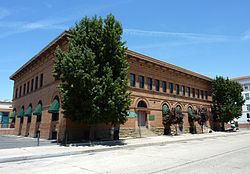Built 1893 NRHP Reference # 84000780 Area 1,600 m² | Architect Schultze, Henry A. Opened 1893 Added to NRHP 29 March 1984 | |
 | ||
Architectural style Late 19th And 20th Century Revivals, Second Renaissance Revival Similar First Baptist Church, Kern County Hall of Re, Green Hotel, McMurtrey Aquatic Center, Bakersfield Ice Sports Center | ||
The Tevis Block, also known as the Kern County Land Company Building, is a historic office building in Bakersfield, California. The structure was placed on the National Register of Historic Places (NRHP) on March 29, 1984.
Contents
Structure
The Tevis Block is a two-story, U-shaped structure constructed of imported fire brick. The front, south-facing facade has fanlight windows and terra cotta arches. Each floor is articulated differently and treated with a different order and finish. Basement windows are rectangular and bottom-hinged with a flat lintel. The first floor windows, two-sash and divided vertically with the fanlight transom, are enhanced by the brickwork to give the appearance of including mezzanine windows. The second-story windows are single-light sash with flat radiating bricks above. Atop the second-story windows is a narrow frieze with square vents topped by a decorated boxed cornice capped by a high plain cornice. The rear of the building includes an enclosed elevator, added later, and a second-story, iron-railed walkway. An additional one-story brick wing was added to the northwest corner of the building in later years.
Significance
The Tevis Block is the final vestige of the Kern County Land Company. The Company was formed in 1890 by James Haggin and his brother-in-law Lloyd Tevis and prospered in developing the areas around the Kern River. The building helped open up the Bakersfield downtown west of H Street and became a landmark upon construction. It was one of only a handful of unreinforced masonry buildings to survive the 1952 Kern County earthquake, and was subsequently strengthened, renovated and restored to a close proximity of its original architecture. It is considered a fine example of Second Renaissance Revival architecture.
